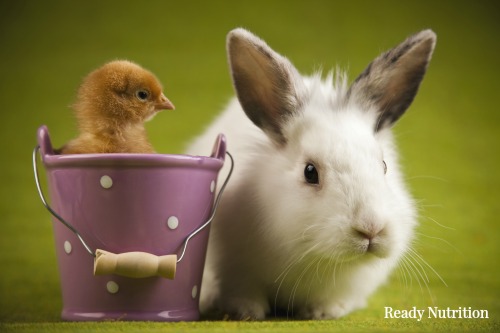When Easter morning arrives, children scramble out of their beds to see if the Easter Bunny visited. With wide eyes, they peer into their baskets; when lo and behold there is the fuzziest little rabbit and chick waiting for them. The parents stumble into the living room to see their child’s expression of their new pets. The parents look on with pride as their children are playing, petting and loving their new bunny and chick. No doubt the parents feel they have scored major parent points. Unfortunately, this story does not have a happy ending. As soon as the real life responsibility comes into play, the novelty wears off and these fuzzy friends get the boot.
According to the Utah Humane Society, “Within the first few weeks of Easter, an estimated 30 percent of all Easter ‘pets’ (bunnies, chicks and ducks) die, and another 70 percent to 80 percent are abandoned or turned in to shelters.” Our warped society has turned living animals (that require adequate shelter and food), into playthings. And, as with all toys, children grow old of them and move on to other things.
According to an article at Huffington Post, one Florida farmer has a solution.
He is offering an alternative that comes with a life lesson. He’ll take in unwanted Easter pets and eventually use them for food.
“I’m not going to make it all soft and cotton candy-like,” says Tom Carey, owner of Sundew Gardens, an organic farm about half an hour from Orlando. “They will be very humanely processed down the road.”
Of course, this proposal raises some rather uncomfortable questions, such as where meat comes from, and why even the most devout meat eaters might feel squeamish about eating an animal that, even briefly, was someone’s pet. You might even get thinking about society’s relationships with all animals.
Although this man has offered a more humane existence for the animals, he has come under scrutiny for his lifestyle choice to butcher his livestock. It seems that the general consensus in our society is that they would rather see an animal sit traumatized in a shelter where, chances are, it will be euthanized after only living a few short months rather than allowing the animal to live a quality existence until its inevitable demise. Regarding the statement that the “most devout meat eaters might feel squeamish about eating an animal that was briefly a pet.” Naturally, you develop a relationship with any livestock. You want it to be healthy, you spend time with it, feed it, care for it. But, when the time comes, you know it will be a food source.
The Taboo Mindset
It seems that it is taboo in our society to eat anything that was once furry and cute. A perfect example of this is an outrageous boycott on Whole Foods for selling rabbit meat. In August 2014, Whole Foods announced it would be adding the adorable lagomorphs (rabbits) to its butcher section, only to be met with outrage, petitions, and calls for boycotts from animal-rights organizations.
Here’s what I would like to know: Why aren’t these “animal-rights groups” boycotting and lecturing the irresponsible adults who give their children farm animals as a cuddly gift and then abandon them when they don’t want to care for them anymore? Why is there more debate about a farmer saying he will make sure the animals lives well until the butcher time comes, and not a peep is spoken about how thirty percent of Easter ‘pets’ that die from ill-treatment?
Is it strange to think this is normal?
I realize the farmer who has come under scrutiny does not live a “normal” lifestyle where one runs to the store for everything. Instead, he chooses to live on his own terms and raise his food sources. But, how taboo is this really? Isn’t this the natural way our ancestors lived? They raised their food and harvested it by their own hands? I find it unnerving how largely removed we are from our food and how quickly our society is to attack someone from living according to those long-forgotten terms. On average, food travels thousands of miles before it reaches our plate. How natural is that?
It’s time that we get back to living a more mindful existence. Those of you looking at sustainable ways to live, or are looking for raising livestock in an urban setting should consider chickens and rabbits. Although chickens and rabbits are cute and fuzzy, they are the gateway drug for raising livestock. They are two of the easiest to raise, are relatively disease-free, live on a similar diet, are good protein sources, are low-fat and can easily live in small spaces. You may be interested in some of these articles on the subject:
Raising Rabbits for Urban Survival
Killing Our Dinner i.e. What Homesteading is Really All About
Rabbits As A Survival Food Source
What to Feed Your Micro-Livestock
Rather than purchasing a chick or rabbit as a “pet,” help raise this animal with your child and show them the importance of raising sustainable food sources. These small micro-livestock do not have to be raised for butchering. My family has had chickens for years that we use mainly for eggs and manure. As well, rabbits can also be used for manure.Children need to know how to respectfully care for animals that will further sustain us. As well, they should know where their food comes from and what it takes to raise quality food sources.
This article was originally published at Ready Nutrition™ on April 9th, 2015







